Semi-annual report | Blockchain patent application volume drop-type decline: Ali Tencent fell out of the top ten net heart against the market into the top four
After 2018, the blockchain patent application in the first half of 2019 cooled somewhat.
The inter-chain pulse query innojoy patent platform shows that the number of patent applications in China's blockchain in the first half of 2019 was 909, which was only 16.2% of the 5,606 pieces in the whole year.
It is worth noting that although Alibaba still occupies the first place in the total number of patents in the blockchain, in the first half of 2019, the number of patent applications for blockchains has been increased by 10, and the network technology of Thunder Group has entered. fourth.
Patent indicators have multiple meanings for blockchain enterprises, such as investment in R&D, quality of talents, and emphasis on innovation. From this you can understand the other side of the development of blockchain.
- Interpretation of the market | Exemption from goods and services tax, is the encryption pass officially recognized?
- Market Analysis: BTC forms a contraction triangle, which is about to change
- Opinion: Facebook stable currency technology may become the mainstream of blockchain in the future
Industry technology investment is getting colder?
Regardless of Chinese and foreign, the number of patent applications related to blockchains fell in the first half of 2019.
Mutual chain pulse searches for “blockchain” keywords through the patent inquiring system innojoy. Halfway through 2019, the number of blockchain patent applications is only 909, which is 16.2% of last year. It is expected that this year is difficult to reach again. The number of 2018.
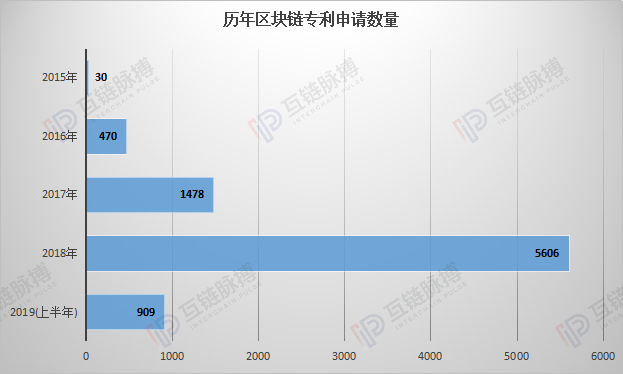
(Cartography: Interchain Pulse Data Source: innojoy)
The situation in other markets around the world is also not optimistic. Searching for "blockchain", the number of patent applications in the first half of this year was only 158, accounting for only 7% of last year.
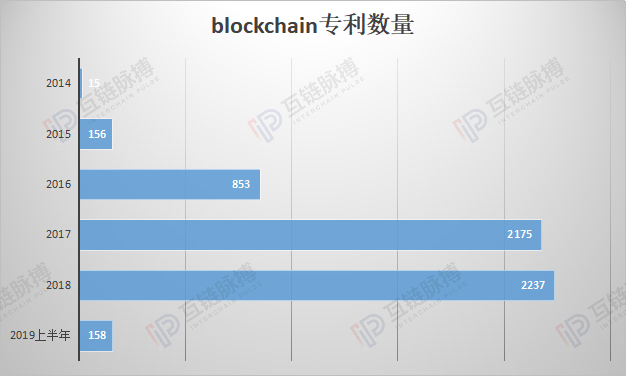
(Cartography: Interchain Pulse Data Source: innojoy)
This kind of decline is caused by the fact that the development of blockchain technology may enter the platform period, and the patent layout in the blockchain field has entered the final stage. The patents for this application have been applied, which has naturally reduced the investment; on the other hand, the blockchain has landed. The application results are insufficient, and the short-term results are not seen. Enterprises with KPIs as the target of assessment naturally reduce the investment in the blockchain. Finally, it may be the market reason. The price of encrypted assets collapsed in the second half of 2018, affecting the financing of block enterprises. Production and other activities, which in turn affected the application for patents.
Where did Ali and Tencent go?
The most surprising thing is that Ali is not so "aggressive" in the 2019 blockchain patent. In 2017 and 2018, he won the "champion" for two years. In the top ten this year, he even found him missing.
According to the data obtained by innojoy of the inter-chain pulse query, Alibaba Group applied for 12 patents in the first half of 2019, which can only be ranked 12th.
In addition, another major Internet company, Tencent, also significantly slowed down the pace of blockchain development. In the first half of the year, the number of related patent applications was only 7 and ranked 22nd.
In the first half of the year, the largest number of applications was China Unicom, with 50. Ping An Technology, Complex Beauty, Net Heart Technology, and Baidu ranked 2-5 in 27, 25, 23, and 20 applications respectively.
It is worth noting that, with the number of patent applications for new blockchains in the year, this year, Netcore Technology entered the top five for the first time. The total number of patents in the blockchain of the company is 95, and the rankings in the past year have entered the top ten, which is more prominent. representative.
Similar to the previous two years, among the top ten, there are two original blockchain companies – complex beauty and interesting chain technology.
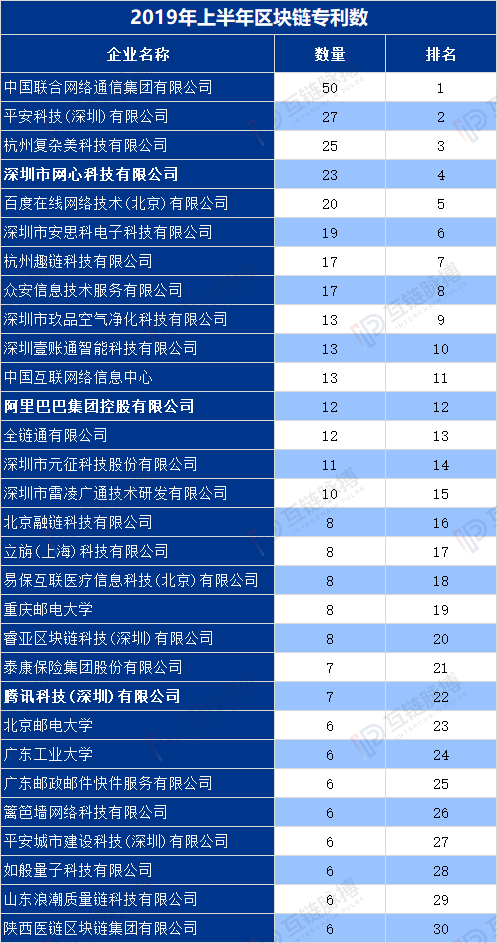
(Cartography: Interchain Pulse Data Source: innojoy)
China's blockchain patent top ten evolution
Native blockchain companies initially dominated the relevant patents.
In 2015, China's blockchain patent application began to take off, with a total of 30 applications. The earliest batch of original blockchain companies became the main force of blockchain patent applications. The Bubi blockchain, established in 2015, applied for eight related patents.
In 2016, it continues to be the world of the original blockchain company. In addition to the Bubi blockchain, Hangzhou Yunxiang blockchain, Hangzhou Complex Beauty, Beijing Tiande Technology, and Beijing Zhongxiangbit Technology have batch blockchain patent applications. . In the same year, the number of patent applications for blockchain jumped to 470.
It is worth noting that in 2016, Internet and financial technology companies joined the blockchain research, and Alibaba (7) and China UnionPay (8) patent applications indicated their business layout in the blockchain.
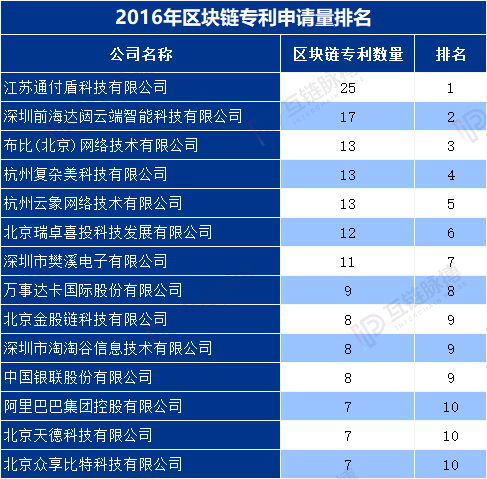
(Cartography: Interchain Pulse Data Source: innojoy)
In 2017, more company organizations joined the blockchain research, and the number of patent applications in 1478 cases in the year was more than three times that of 2016. That is, in that year, Alibaba blockchain patent applications broke out (57) and became a blockchain patent.
Through the list of patents in the current year, it can be seen that a number of traditional large-scale companies have poured into the blockchain research, including Tencent, China Merchants Bank, China Unicom, Inspur Technology, and Dianrong. . However, the original blockchain companies such as the medium chain, the only chain, the European chain, the interesting chain, etc., all ranked in the top ten.
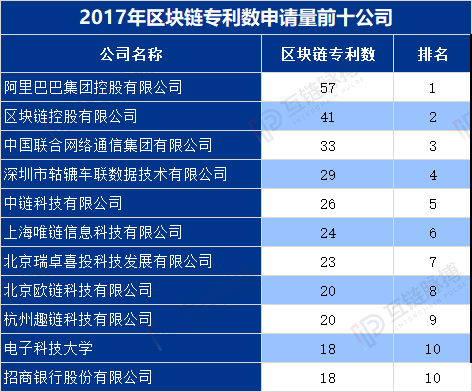
(tabulation: interchain pulse data source: innojoy)
In 2018, the number of patent applications for blockchain reached 5,606. Traditional technology companies are accelerating their deployment in the blockchain sector. Ping An Technology, Baidu, Tencent, Zhongan and Thunder Group's NetScience Technology entered the top ten patent applications of the year, and squeezed out the original blockchain company. Among the top ten, there are only two complex blockchain companies in the complex beauty and medium chain.

(tabulation: interchain pulse data source: innojoy)
Traditional technology companies and financial stock companies have advantages in technology, talents, and markets. Most of them are market-leading for blockchain patents.
Blockchain three poles
As of the end of the first half of 2019, the number of applications for blockchains in China exceeded 8,440. Alibaba still tops the list with 257 pieces. Complex Beauty and Medium Chain Technology are two native blockchain companies.
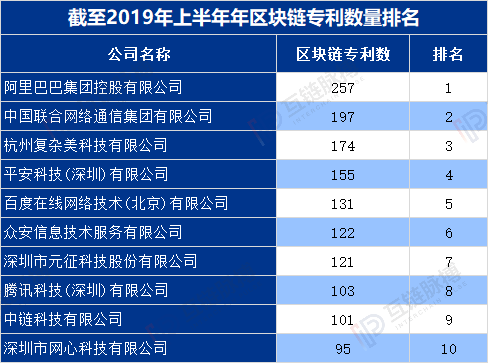
(tabulation: interchain pulse data source: innojoy)
The top 30 companies in the inter-chain pulse selection blockchain patent number are further subdivided into Internet companies, financial technology companies, blockchain companies, communication companies, Internet of things companies, universities and computer companies according to their fields.
There is currently a "three-point world" situation. The top 30 applied for a total of 2,431 patents for blockchain. Among them, Internet companies applied for 722 patents, accounting for 29.66%, including Alibaba, Baidu, Tencent, and Netcore Technology; followed by blockchain companies, applying for 547 patents, accounting for 22.5%, including complex beauty. , medium chain, cloud elephant, European chain, etc.; 543 applications for financial technology, accounting for 22.2%, including Ping An Technology, Dianrong Network, Taikang Life Insurance, Weizhong Bank, etc.

(Cartography: Interchain Pulse Data Source: innojoy)
The regional distribution of the top 30 patents in the blockchain is also showing a three-point world. Companies registered in Beijing applied for 845 patents, accounting for 34.7%, including China Unicom, Baidu, China Chain, Qihoo, etc.; 830 registered companies in Shenzhen, accounting for 34.1%, including Ping An Group, Tencent, Netxin Technology, Yuanzheng Technology, etc.; 510 registered companies in Hangzhou, accounting for 21%, including Ali, complex beauty, cloud, secrets and so on. The performance of blockchain companies such as Guangzhou and Shanghai is not outstanding.
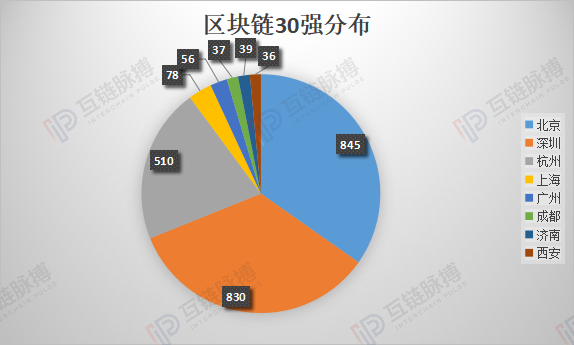
(Cartography: Interchain Pulse Data Source: innojoy)
On June 18th, the Libra white paper was born, once again set off the community's attention to the blockchain. In the second half of the year, will the public invest more in the study of the blockchain, and whether the number of patent applications in the blockchain will be improved will remain to be seen.
Author: Mutual chain pulse commentator Yuan yet
This article is [inter-chain pulse] original, reproduced please indicate the source!
We will continue to update Blocking; if you have any questions or suggestions, please contact us!
Was this article helpful?
93 out of 132 found this helpful
Related articles
- Nobel Prize winner Stiglitz: The fool will believe in Facebook's Libra
- Science | Layer 2 Solution Overview: From Status Channel to Roll Up
- "Old World" Deutsche Bank layoffs, "New World" bitcoin broke through 12,000 US dollars
- Weekly market report | overall market value, transaction volume both callbacks, BTC weekly maximum increase of 23.29%
- Morning market: Bitcoin broke through 12,000 US dollars to keep going up, even the market is just around the corner
- The form of money: from physical currency to cryptocurrency
- Research Report | Libra is a fixed income ETF





